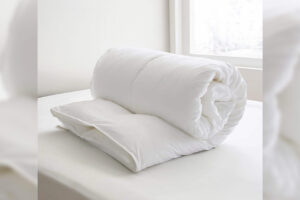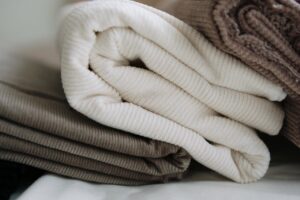Clothes alteration services are temporarily unavailable at all locations.
How Does Dry Cleaning Work? Know the Secrets Behind the Process
- By White's Laundry
- 28 July 2025
When you drop off your clothes at the dry cleaner, they disappear behind the counter and come back clean, crisp, and neatly pressed. But have you ever wondered what actually happens in between? Despite the name, dry cleaning isn’t really “dry” and it involves more than just tossing your clothes into a fancy machine.
In this blog, we’ll reveal the secrets behind the dry cleaning process so you can better understand how your clothes are professionally cleaned and cared for.
What is Dry Cleaning?
Dry cleaning is a cleaning process for clothes and fabrics that uses chemical solvents instead of water. It’s especially useful for delicate materials like silk, wool, and embellished fabrics that could shrink, stretch, or get damaged in a regular washing machine.
Unlike traditional laundering, dry cleaning avoids water altogether, relying on specialized solvents to remove stains, oils, and dirt without damaging the fabric structure.
The Dry Cleaning Process – Step by Step
Here’s what typically happens when you send your garments to a professional cleaner:
Tagging & Inspection
Each item is tagged with a unique ID for tracking. The cleaner also inspects for stains, missing buttons, loose threads, or fabric damage. This step ensures that the clothes are treated correctly and returned to the right customer.
Pre-Treatment
Visible stains like wine, grease, or ink are treated individually using spot removers before the full cleaning cycle begins. This helps prevent stains from setting during the solvent wash.
Cleaning in Solvent
Clothes are placed in a specialized dry cleaning machine that looks a bit like a large front-loading washer. Instead of water and detergent, it uses a liquid solvent (more on that below) to gently agitate and clean the fabric. The solvent dissolves oils and grime without saturating the fabric like water does.
Drying
Once cleaned, the solvent is extracted, and the garments go through a controlled drying process using warm air. The machines are designed to recover and recycle the solvent for reuse, making the process more efficient.
Post-Spotting & Finishing
After cleaning, each item is re-inspected for any lingering stains or spots. Final touches like steaming, pressing, and folding are done to restore the garment to its best condition before packaging.
What Solvents Are Used in Dry Cleaning?
Dry cleaning solvents are the key to the entire process. The most commonly used ones include:
- Perc (Perchloroethylene): The traditional choice, very effective but potentially harmful if not handled properly.
- Hydrocarbon Solvents: Milder and more environmentally friendly, but may not be as effective on certain stains.
- Silicone-Based Solvents: Gentle on fabrics and considered safer for the environment.
- Liquid CO₂: A high-tech option that’s eco-friendly but less widely available.
These solvents are chosen based on fabric type, environmental regulations, and effectiveness. Unlike water, they don’t cause fibers to swell or shrink, making them ideal for delicate garments.
What Types of Clothes Need Dry Cleaning?
Some fabrics and garments are just too delicate for machine washing. Common items that benefit from dry cleaning include:
- Wool suits and coats
- Silk blouses and dresses
- Rayon or acetate garments
- Beaded, embroidered, or sequined items
- Structured garments like blazers or tuxedos
Always check the care label, if it says “Dry Clean Only,” trust the experts.
Common Myths About Dry Cleaning – Debunked
Let’s clear up a few common misunderstandings:
- “Dry cleaning is dry.”
Not exactly. The process uses liquid solvents, just no water. - “Dry cleaning wears out clothes.”
On the contrary, dry cleaning can help extend garment life by avoiding harsh washing. - “All stains can be removed.”
While dry cleaning is powerful, some stains (especially older or heat-set ones) can be difficult to remove completely.
How Often Should You Dry Clean Clothes?
It depends on how often you wear the item and the type of fabric:
- Suits: Every 2–3 wears
- Formal dresses: After every use
- Wool coats: A few times per season
- Silk or delicate blouses: Every 1–2 wears, depending on sweating and spills
Between visits, try to air out your garments and use garment bags to keep them fresh.
Dry Cleaning vs. Home Care
Should you always rely on dry cleaning? Not necessarily.
When to choose dry cleaning:
- The label says “Dry Clean Only”
- There are stains or delicate details
- It’s a valuable or structured item
When home care may be fine:
- The label says “Dry Clean Recommended”
- The item is casual and made of washable fabrics
- You’re using a gentle detergent and cold water
Just be careful, DIY dry cleaning kits or washing delicate clothes at home can sometimes backfire.
Tips for Getting the Best Results from Your Dry Cleaner
- Point out stains when dropping off your clothes so they can be pre-treated.
- Empty all pockets and remove accessories like brooches or cufflinks.
- Don’t store clothes in the plastic covering, it can trap moisture. Transfer them to breathable garment bags.
Building a relationship with a trusted dry cleaner ensures your clothes get the care they deserve.
Conclusion
Dry cleaning isn’t just for luxury, it’s a scientifically designed process that protects your favorite clothes and extends their life. Now that you know the secrets behind how it works, you can confidently care for your wardrobe and make informed choices about when and how to use professional cleaning services.
So next time you pick up your freshly pressed outfit, you’ll know exactly what went into making it look that good!





